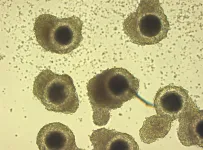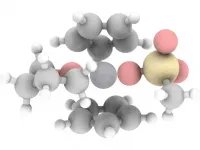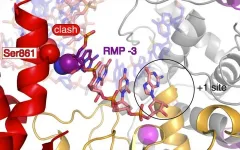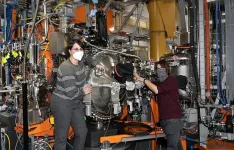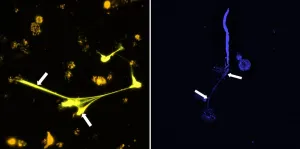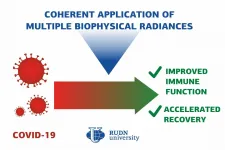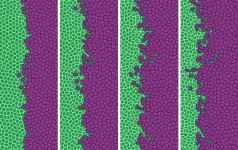INFORMATION:
Publications
Zahmel J, Jänsch S, Jewgenow K, Sandgreen DM, Simonsen KS, Colombo M (in press; online preprint): Maturation and fertilization of African lion (Panthera leo) oocytes after vitrification. CRYO BIOL, https://doi.org/10.1016/j.cryobiol.2020.11.011.
Colombo M, Zahmel J, Binder C, Herbel J, Luvoni GC, Jewgenow K (in press; online preprint): Ovary cold storage and shipment affect oocyte yield and cleavage rate of cat immature vitrified oocytes. CRYO BIOL, https://doi.org/10.1016/j.cryobiol.2020.11.003.
Contact
Leibniz Institute for Zoo and Wildlife Research (IZW)
in the Forschungsverbund Berlin e.V.
Alfred-Kowalke-Str. 17
10315 Berlin
PD Dr. Beate Braun
Scientist Department of Reproduction Biology
+49 30 5168 614
zahmel@izw-berlin.de
Prof. Dr. Katarina Jewgenow
Head Department of Reproduction Biology
+49 30 5168 506
jewgenow@izw-berlin.de
Steven Seet
Head Science Communication
+49 30 5168 125
seet@izw-berlin.de
Scientists produce the first in-vitro embryos from vitrified African lion oocytes
2021-01-19
(Press-News.org) For this specific method of cryopreservation, oocytes are collected directly after an animal is castrated or deceased and immediately frozen at -196°C in liquid nitrogen. This technique allows the storage of oocytes of valuable animals for an unlimited time, so that they can be used to produce offspring with the help of assisted reproduction techniques. The aim is to further improve and apply these methods to save highly endangered species such as the Asiatic lion from extinction. The current research on African lions as a model species is an important step in this direction. The results are reported in the scientific journal Cryobiology.
Lion oocytes are presumed to be very sensitive to chilling due to their high lipid content, resulting in poor revival following slow cooling. Vitrification can circumvent this problem, as the cells are frozen at ultra-fast speeds in solutions with a very high concentration of cryoprotective agents. This method prevents the formation of ice crystals in the cells, which could destroy them, and enables them to remain intact for an unlimited time to allow their use later on.
For the present research, the scientists collected oocytes from four African lionesses from Givskud Zoo - Zootopia after the animals had been euthanised for the purpose of population management. Half of the oocytes (60) were vitrified instantly. After six days of storage in liquid nitrogen, the vitrified oocytes were thawed and subjected to in-vitro maturation in an incubator at 39°C for a total of 32-34 hours. The other half (59) were used as control group and directly subjected to in-vitro maturation without a step of vitrification. Mature oocytes of both groups were then fertilised with frozen-thawed sperm from African lion males. "We could demonstrate a high proportion of surviving and matured oocytes in the group of vitrified oocytes. Almost 50 % of them had matured, a proportion similar to that in the control group," says Jennifer Zahmel, scientist at the Department of Reproduction Biology at the Leibniz-IZW. Of the vitrified group, seven early embryos developed, whereas in the control group only three embryos developed. "To our knowledge, this is the first time that in-vitro embryos were produced following vitrification of oocytes from African lion or any other wild cat species," says Martina Colombo from the University of Milan and guest scientist at the Leibniz-IZW.
In a recent scientific study on the domestic cat, conducted in cooperation with colleagues from the University of Milan and the University of Veterinary Medicine Vienna, the reproduction biology team of the Leibniz-IZW demonstrated that an immediate on-site vitrification of felid oocytes is the best option to obtain a high number of good quality gametes and consequently a higher number of developing embryos. This study was also published in Cryobiology. On-site vitrification is especially useful if samples are collected from wildlife kept in zoos and then need to be transported to a suitable lab. "Transportation of fresh oocytes and ovarian tissue across international borders is often complex and critical in terms of time, whereas on-site vitrification of oocytes allows a safe time period for transportation. The oocytes can be fertilised at a later point, once they have been transported to a suitable lab and sperm of a male is available," Zahmel explains.
The present research demonstrates successful vitrification, in-vitro maturation and fertilisation of African lion oocytes for genetic resource banking. Yet, none of the early embryos from vitrified oocytes developed beyond the 4-cell stage. Clarifying the pathways that are affected by vitrification would be important to get a better understanding of the specific needs vitrified oocytes may have after thawing. "Though embryo development was still impaired, our results give hope that felid oocytes can be cryopreserved and stored in biobanks in future," says Katarina Jewgenow, Head of the Department Reproduction Biology at the Leibniz-IZW. "Our aim is to further improve these methods in model species such as domestic cats and African lions in order to use them one day for the assisted reproduction of endangered felids such as the Asiatic lion," Jewgenow adds.
ELSE PRESS RELEASES FROM THIS DATE:
Researchers develop sustainable catalysis process
2021-01-19
Acetals are important chemical compounds that are used, for example, in the production of certain medical agents. A new method now makes their synthesis easier and more environmentally friendly. Chemists at the University of Bonn have developed and optimized the sustainable catalytic process. State-of-the-art computer simulations were also used. The reaction is based on a mechanism that frequently occurs in nature, but has rarely been used in chemical synthesis up to now. The results are published in the journal Angewandte Chemie.
The key step in the production of acetals is the bonding of two oxygen ...
Why remdesivir does not fully stop the coronavirus
2021-01-19
Remdesivir is the first drug against Covid-19 to be conditionally approved in Europe and the United States. The drug is designed to suppress the rapid replication of the SARS-CoV-2 virus in human cells by blocking the viral copying machine, called RNA polymerase. Researchers at the Max Planck Institute (MPI) for Biophysical Chemistry in Göttingen and the University of Würzburg have now elucidated how remdesivir interferes with the viral polymerase during copying and why it does not inhibit it completely.
"After complicated studies, we come to a simple conclusion," Max Planck Director Patrick ...
Scientists streamline process for controlling spin dynamics
2021-01-19
UPTON, NY--Marking a major achievement in the field of spintronics, researchers at the U.S. Department of Energy's (DOE) Brookhaven National Laboratory and Yale University have demonstrated the ability to control spin dynamics in magnetic materials by altering their thickness. The study, published today in Nature Materials, could lead to smaller, more energy-efficient electronic devices.
"Instead of searching for different materials that share the right frequencies, we can now alter the thickness of a single material--iron, in this case--to find a magnetic medium that will enable the transfer of information across a device," said Brookhaven physicist and principal investigator Valentina ...
Researchers discover potential new therapy for chemotherapy-resistant breast cancer
2021-01-19
Scientists have discovered a molecule that can selectively kill cells of a hard-to-treat subtype of breast cancer, which could lead to a new therapy.
The study, led by researchers at RCSI University of Medicine and Health Sciences, is published in the current edition of Science Advances.
Triple negative breast cancer is a subtype of breast cancer which is mainly treated with chemotherapy. Unfortunately, up to 70% of patients with this form of breast cancer develop resistance to treatment.
The researchers tested different molecules to see if they could selectively kill the cells of this type of breast cancer while sparing normal ...
As the American hemp industry grows, so does our understanding of hemp diseases
2021-01-19
As hemp begins to reemerge as an important crop in the United States, scientists are beginning research into the diseases that might prevent the crop from flourishing. A study published in the December issue of Plant Health Progress is one of the first to study the potential disease and disorder limitations for hemp production in the southeastern United States.
Lindsey Thiessen, a plant pathologist at North Carolina State University, worked with colleagues to evaluate hemp samples from North Carolina and observed 16 different diseases. They found Fusarium flower blight most consistently followed by Helminthosporium ...
UN disaster aid is driven by humanitarian need rather than by strategic donor interests
2021-01-19
A new study published in PNAS finds that aid provided by the United Nations (UN) in the aftermath of climate-related disasters is driven by humanitarian need rather than by strategic donor interests. The results underline the importance of climate-related hazards for understanding aid disbursements.
The study 'Humanitarian need drives multilateral disaster aid' provides the first estimation of UN climate-related disaster aid worldwide. Although it cannot be entirely ruled out that powerful donor states' interests shape UN aid flows, the UN seems able to fend off donor states' strategic ...
A trap for nematodes
2021-01-19
Filariae, slender but sometimes up to 70 centimeters long nematodes, can set up residence in their host quite tenaciously and cause serious infectious diseases in the tropics. The tiny larvae of the worms are usually transmitted from person to person by mosquitoes, which pick up the larvae from the blood or subcutaneous tissue when they bite and deposit them in the vessels or tissues of their next victim. Researchers led by the University of Bonn (Germany) have now investigated a mechanism by which the immune system attacks the filariae. Certain immune cells, the eosinophil granulocytes, release DNA that forms a kind of web around the larvae and traps them. The researchers ...
Increased blood flow during sleep tied to critical brain function
2021-01-19
Our brains experience significant changes in blood flow and neural activity during sleep, according to Penn State researchers. Such changes may help to clean out metabolic brain waste that builds up during the day.
"We studied the sleep patterns of mice during both rapid eye movement and non-rapid eye movement sleep stages, as well as in different alertness states," said Patrick Drew, Huck Distinguished Associate Professor of Engineering Science and Mechanics, Neurosurgery and Biomedical Engineering.
Mice were chosen for the study because of their brains' remarkable similarity with human brains, said the researchers.
In both mice and humans, non-REM sleep ...
RUDN University and RLT scientists: Light, magnetic field, and ultrasound could help fight COVID-19
2021-01-19
A team of researchers from RUDN University and RLT suggested restoring normal levels of lymphocytes in patients with COVID-19 and other viral diseases by subjecting them to the combined influence of light, magnetic field, and ultrasound. The results of the study were published in the Journal of Photochemistry and Photobiology B: Biology.
Some COVID-19 patients are asymptomatic, while others suffer from complications. To effectively fight coronavirus with drugs and therapeutic methods, scientists and medics have to find out what causes these differences in the course of the disease. A team of scientists from RUDN University together with their colleagues from the international company Radiant Life Technologies (RLT) suggested that the reason might ...
A mathematical study describes how metastasis starts
2021-01-19
A scientific study carried out by the Universidad Carlos III de Madrid (UC3M) and the Universidad Complutense de Madrid (UCM) has produced a mathematical description of the way in which a tumor invades the epithelial cells and automatically quantifies the progression of the tumor and the remaining cell islands after its progression. The model developed by these researchers could be used to better understand the biophysical characteristics of the cells involved when developing new treatments for wound healing, organ regeneration, or cancer progression.
This research analyses the collective ...
